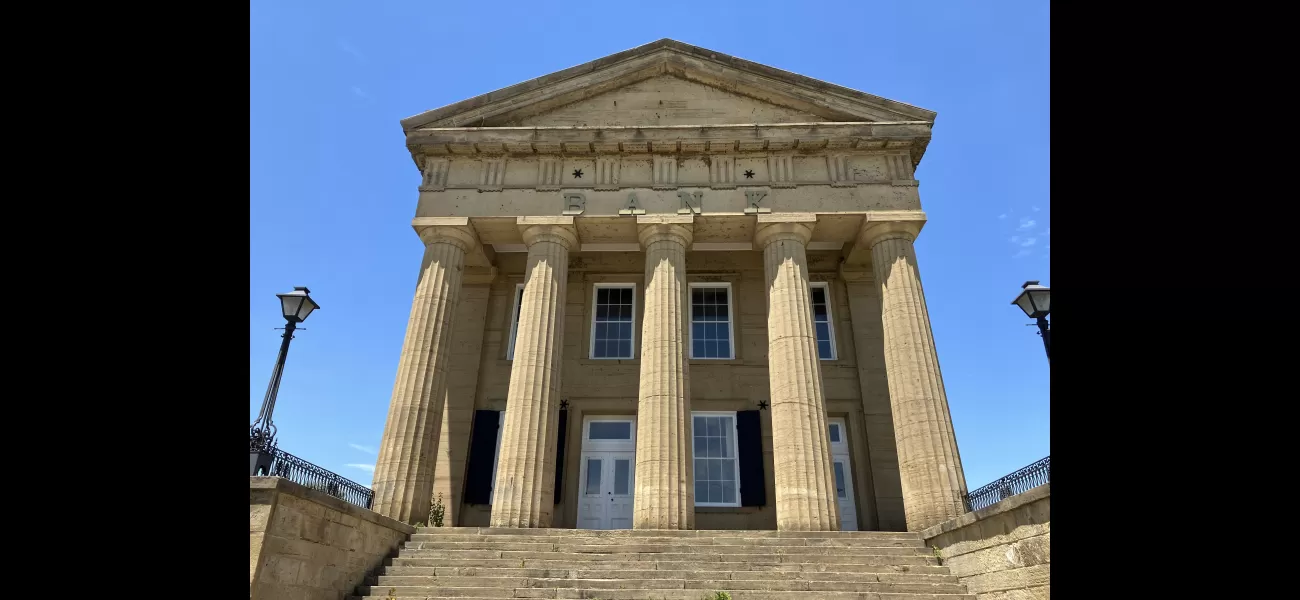The oldest bank in Illinois is one of many endangered landmarks in the state.
Historic Shawneetown Bank faces threat, but aid may be on the way.
June 16th 2024.

Before the Ohio River flooded and destroyed it, there was a metal grate on the floor of the first bank building in Illinois. This bank was actually a log house in Old Shawneetown, owned by John Marshall. After earning money in the nearby salt mines, he dedicated one room for banking operations. Tamara Briddick, a member of the Gallatin County Historical Society, shared that there was a guard in the basement where the money was lowered into a barrel. The guard often slept on top of the barrel to keep a close eye on the valuable contents.
Old Shawneetown was one of the newest American settlements west of the Ohio River, but it had a long history as a population center for the Shawnee people. In the late 1700s, the federal government established the town as home to a land office, which helped to solidify the new nation's holdings in the Northwest Territory. A few years later, Illinois became a state and the bustling river port of Shawneetown became home to the state's first bank in 1821. Briddick believes that this event was the start of the state's creation.
The Old Shawneetown Bank State Historic Site, located in Old Shawneetown, Illinois, is considered the oldest standing bank building in the state. Recently, it was named one of the 2024 Most Endangered Historic Places in Illinois by Landmarks Illinois. This imposing structure was built in 1838 and served as the state's first bank. Today, it stands alone in a town that has been mostly abandoned for over 80 years. However, it is one of the properties that is at the center of a new legislation awaiting the signature of Governor J.B. Pritzker. This bill would establish a State Historic Preservation Board within the Illinois Department of Natural Resources, which would be responsible for evaluating the state's historic properties.
Quinn Adamowski of Landmarks Illinois is pleased with this move, as he believes that the 56 designated State Historic Sites in Illinois are in varying conditions due to a lack of resources available to the IDNR. While some of these sites have received budget increases in recent years, there is still a significant need for maintenance and repairs. In Old Shawneetown, this lack of attention is nothing new. The town was once a popular destination, visited by famous explorers like Lewis and Clark, and even Abraham Lincoln. However, it is now known mostly for what used to be there.
The first incarnation of the First State Bank of Illinois lasted only a few years before it was reborn as the State Bank of Illinois in the 1830s. In 1838, a grand 3-story brick building with five massive doric columns opened on the dry side of the Shawneetown levee, just a block west of Main Street. One of the first orders of business for this impressive new bank was considering proposals from the growing city of Chicago. However, Shawneetown's bankers ultimately turned down their request for a loan, citing the distance between the two cities as a major factor.
According to local lore, the reason for the loan refusal was that Chicago was considered too far away from the Ohio River to be successful. However, a letter dated July 5, 1838, addressed to Chicago Mayor Buckner Stith Morris and now housed at the Gallatin County Historical Society, reveals that the city first asked for a branch of the bank to be established there. When that request was denied, they then asked for a loan, which was also turned down. Briddick explains that this was simply a matter of banking norms, as it would have been difficult for the bank to retrieve their money from a city so far from the river.
Fortunes in Shawneetown rose and fell quickly, much like the changing levels of the Ohio River. The "five column bank" opened and closed five times before being purchased by Governor Joel Matteson in 1853. However, less than 10 years later, it was sold for a fraction of the price to local resident Thomas Ridgeway, who made it his home. It eventually reopened as a bank under Ridgeway's leadership, but the unpredictable river had other plans.
In 1937, the historic Ohio River flood devastated Old Shawneetown, washing away Main Street and reducing the first bank building in Illinois to its root cellar. The water levels can still be seen on the massive columns out front of the building, a reminder of the town's history and the power of the river. Despite the destruction, some buildings and the bank itself remained standing, but the town was never the same. Briddick reflects on this tragic event and the town's resilience in the face of adversity.
Long before the devastating Ohio River floods swept through the town of Old Shawneetown, there stood a humble log house that served as the first bank building in Illinois. Originally owned by John Marshall, who had accumulated wealth from the nearby salt mines, this simple structure was dedicated to the operations of banking.
Tamara Briddick, a member of the Gallatin County Historical Society, recalls that there was a metal grate in the floor of the bank, through which all forms of currency - gold, silver, and paper money - were lowered into a barrel in the basement. The barrel was guarded by a man who often slept on top of it, ensuring the safety of the valuable contents.
Despite being one of the newest settlements west of the Ohio River, the town of Old Shawneetown had a long history as a center for the Shawnee people. It was officially established by the federal government in the late 1700s, as part of the Northwest Territory. When Illinois became a state a few years later, Shawneetown became home to the state's first bank in 1821.
Briddick proudly states, "We created the state, basically. That's my personal opinion, but it all started right here." The Old Shawneetown Bank State Historic Site, built in 1838, is considered the oldest standing bank building in the state. Recently, it was recognized as one of the 2024 Most Endangered Historic Places in Illinois by Landmarks Illinois.
This impressive structure, with its five massive doric columns, was once the home of the first bank in the state. However, it now stands nearly alone in a town that has been largely abandoned for over 80 years. But this historic building is not forgotten, as it is one of the properties at the center of legislation awaiting the signature of Governor J.B. Pritzker. The bill would establish a State Historic Preservation Board within the Illinois Department of Natural Resources, responsible for preserving the state's historic properties.
Quinn Adamowski of Landmarks Illinois expresses his support for this move, stating that the 56 designated State Historic Sites in Illinois are in varying conditions due to a lack of resources for the IDNR. While some sites have received budget increases in recent years, there is still a need for catch-up on deferred maintenance. This is especially true in Old Shawneetown, where the town's eastern location on a major river route has led to a long history of neglect.
Despite this neglect, Old Shawneetown has a rich history. The town was once visited by Lewis and Clark on their way west, and Abraham Lincoln frequented it as a lawyer and political candidate. Even a hero of the American Revolution made a stop in Shawneetown. However, the town's most famous claim to fame is the first State Bank of Illinois, which opened its doors in 1838.
This bank was short-lived, and after a few years, it was reborn as the State Bank of Illinois with bigger plans and assets. However, the river that brought commerce to the town also brought destruction. In 1937, the historic Ohio River floodwaters ravaged through Old Shawneetown, washing away Main Street and reducing the first bank building in Illinois to its root cellar.
Briddick points to the massive columns of the bank building, still bearing the water lines from that fateful flood. She explains that the town was under 20 feet of water, and most of the buildings were destroyed. The log house that once served as the first bank building in Illinois was now a mere memory, a victim of the powerful Ohio River.
Old Shawneetown was one of the newest American settlements west of the Ohio River, but it had a long history as a population center for the Shawnee people. In the late 1700s, the federal government established the town as home to a land office, which helped to solidify the new nation's holdings in the Northwest Territory. A few years later, Illinois became a state and the bustling river port of Shawneetown became home to the state's first bank in 1821. Briddick believes that this event was the start of the state's creation.
The Old Shawneetown Bank State Historic Site, located in Old Shawneetown, Illinois, is considered the oldest standing bank building in the state. Recently, it was named one of the 2024 Most Endangered Historic Places in Illinois by Landmarks Illinois. This imposing structure was built in 1838 and served as the state's first bank. Today, it stands alone in a town that has been mostly abandoned for over 80 years. However, it is one of the properties that is at the center of a new legislation awaiting the signature of Governor J.B. Pritzker. This bill would establish a State Historic Preservation Board within the Illinois Department of Natural Resources, which would be responsible for evaluating the state's historic properties.
Quinn Adamowski of Landmarks Illinois is pleased with this move, as he believes that the 56 designated State Historic Sites in Illinois are in varying conditions due to a lack of resources available to the IDNR. While some of these sites have received budget increases in recent years, there is still a significant need for maintenance and repairs. In Old Shawneetown, this lack of attention is nothing new. The town was once a popular destination, visited by famous explorers like Lewis and Clark, and even Abraham Lincoln. However, it is now known mostly for what used to be there.
The first incarnation of the First State Bank of Illinois lasted only a few years before it was reborn as the State Bank of Illinois in the 1830s. In 1838, a grand 3-story brick building with five massive doric columns opened on the dry side of the Shawneetown levee, just a block west of Main Street. One of the first orders of business for this impressive new bank was considering proposals from the growing city of Chicago. However, Shawneetown's bankers ultimately turned down their request for a loan, citing the distance between the two cities as a major factor.
According to local lore, the reason for the loan refusal was that Chicago was considered too far away from the Ohio River to be successful. However, a letter dated July 5, 1838, addressed to Chicago Mayor Buckner Stith Morris and now housed at the Gallatin County Historical Society, reveals that the city first asked for a branch of the bank to be established there. When that request was denied, they then asked for a loan, which was also turned down. Briddick explains that this was simply a matter of banking norms, as it would have been difficult for the bank to retrieve their money from a city so far from the river.
Fortunes in Shawneetown rose and fell quickly, much like the changing levels of the Ohio River. The "five column bank" opened and closed five times before being purchased by Governor Joel Matteson in 1853. However, less than 10 years later, it was sold for a fraction of the price to local resident Thomas Ridgeway, who made it his home. It eventually reopened as a bank under Ridgeway's leadership, but the unpredictable river had other plans.
In 1937, the historic Ohio River flood devastated Old Shawneetown, washing away Main Street and reducing the first bank building in Illinois to its root cellar. The water levels can still be seen on the massive columns out front of the building, a reminder of the town's history and the power of the river. Despite the destruction, some buildings and the bank itself remained standing, but the town was never the same. Briddick reflects on this tragic event and the town's resilience in the face of adversity.
Long before the devastating Ohio River floods swept through the town of Old Shawneetown, there stood a humble log house that served as the first bank building in Illinois. Originally owned by John Marshall, who had accumulated wealth from the nearby salt mines, this simple structure was dedicated to the operations of banking.
Tamara Briddick, a member of the Gallatin County Historical Society, recalls that there was a metal grate in the floor of the bank, through which all forms of currency - gold, silver, and paper money - were lowered into a barrel in the basement. The barrel was guarded by a man who often slept on top of it, ensuring the safety of the valuable contents.
Despite being one of the newest settlements west of the Ohio River, the town of Old Shawneetown had a long history as a center for the Shawnee people. It was officially established by the federal government in the late 1700s, as part of the Northwest Territory. When Illinois became a state a few years later, Shawneetown became home to the state's first bank in 1821.
Briddick proudly states, "We created the state, basically. That's my personal opinion, but it all started right here." The Old Shawneetown Bank State Historic Site, built in 1838, is considered the oldest standing bank building in the state. Recently, it was recognized as one of the 2024 Most Endangered Historic Places in Illinois by Landmarks Illinois.
This impressive structure, with its five massive doric columns, was once the home of the first bank in the state. However, it now stands nearly alone in a town that has been largely abandoned for over 80 years. But this historic building is not forgotten, as it is one of the properties at the center of legislation awaiting the signature of Governor J.B. Pritzker. The bill would establish a State Historic Preservation Board within the Illinois Department of Natural Resources, responsible for preserving the state's historic properties.
Quinn Adamowski of Landmarks Illinois expresses his support for this move, stating that the 56 designated State Historic Sites in Illinois are in varying conditions due to a lack of resources for the IDNR. While some sites have received budget increases in recent years, there is still a need for catch-up on deferred maintenance. This is especially true in Old Shawneetown, where the town's eastern location on a major river route has led to a long history of neglect.
Despite this neglect, Old Shawneetown has a rich history. The town was once visited by Lewis and Clark on their way west, and Abraham Lincoln frequented it as a lawyer and political candidate. Even a hero of the American Revolution made a stop in Shawneetown. However, the town's most famous claim to fame is the first State Bank of Illinois, which opened its doors in 1838.
This bank was short-lived, and after a few years, it was reborn as the State Bank of Illinois with bigger plans and assets. However, the river that brought commerce to the town also brought destruction. In 1937, the historic Ohio River floodwaters ravaged through Old Shawneetown, washing away Main Street and reducing the first bank building in Illinois to its root cellar.
Briddick points to the massive columns of the bank building, still bearing the water lines from that fateful flood. She explains that the town was under 20 feet of water, and most of the buildings were destroyed. The log house that once served as the first bank building in Illinois was now a mere memory, a victim of the powerful Ohio River.
[This article has been trending online recently and has been generated with AI. Your feed is customized.]
[Generative AI is experimental.]
0
0
Submit Comment





